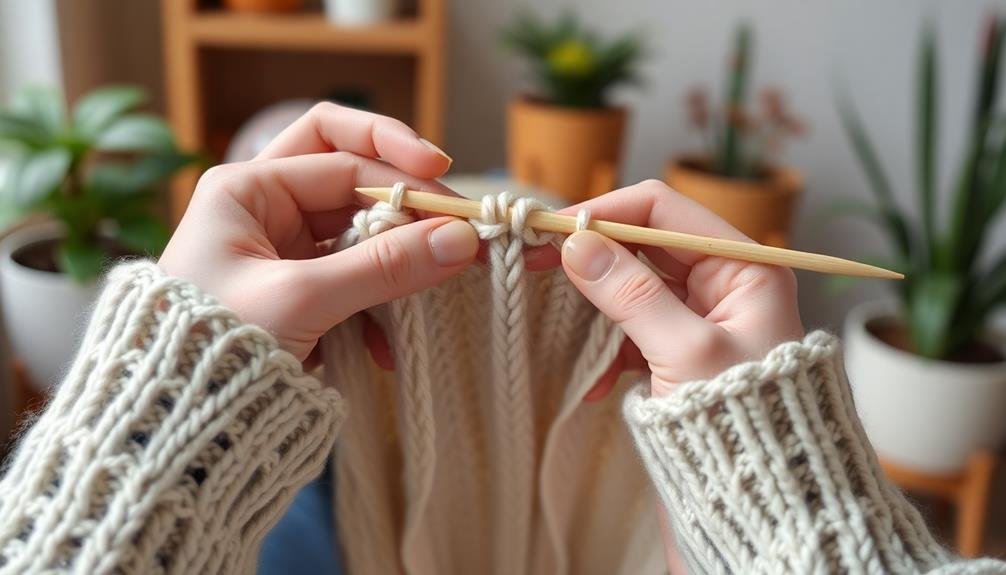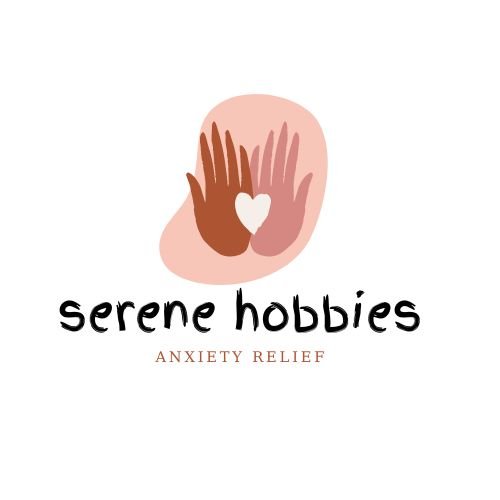Three effective knitting techniques can help ease panic attacks. First, try mindful stitch counting, which redirects your focus from anxious thoughts to the present moment. Second, explore textured grounding patterns like seed stitch or cable knit, engaging your senses through varied textures. Third, practice breath-synchronized knitting rhythms, aligning your stitches with your breath to regain control. These methods combine the repetitive nature of knitting with mindfulness, providing tangible ways to ground yourself during anxiety. By engaging your hands and mind, you'll create a calming anchor in times of distress. Discover how these simple techniques can transform your knitting into a powerful coping tool.
Mindful Stitch Counting

How can something as simple as counting stitches help manage panic attacks? Mindful stitch counting is a powerful technique that combines the repetitive nature of knitting with focused attention, effectively grounding you during moments of anxiety.
When you feel a panic attack approaching, grab your knitting project and begin counting each stitch as you work. Focus intently on the numbers, saying them silently or aloud. This practice redirects your mind from anxious thoughts to the present moment.
As you count, pay attention to the texture of the yarn, the sound of needles clicking, and the rhythm of your hands. Start with small, manageable sections, like counting to ten or twenty stitches. Repeat this process, gradually increasing the number as you feel more centered.
If you lose count, simply start over without judgment. The goal isn't perfection but rather engagement in a calming, repetitive activity.
Textured Grounding Patterns
Texture can be a powerful ally in grounding yourself during a panic attack. When you're feeling overwhelmed, incorporating tactile elements into your knitting can help redirect your focus and calm your senses.
Try experimenting with different stitch patterns that create varied textures, engaging your fingers and mind in a soothing, repetitive process.
Consider exploring these textured patterns to help manage anxiety:
- Seed stitch: Alternating knit and purl stitches for a bumpy, tactile surface
- Cable knit: Creating twists and braids for a complex, raised texture
- Bobbles: Adding small, rounded protrusions for a playful, touchable fabric
- Lace: Incorporating delicate holes and raised sections for a light, airy feel
- Ribbing: Alternating columns of knit and purl stitches for a stretchy, ridged texture
As you work these patterns, pay attention to how the yarn feels in your hands and how the fabric changes with each stitch.
Focus on the sensations of the needles sliding through the loops and the tension of the yarn. This mindful engagement with texture can help anchor you in the present moment, providing a tangible distraction from anxious thoughts and physical symptoms of panic.
Breath-Synchronized Knitting Rhythms

Synchronizing your knitting rhythm with your breath can be a powerful technique for managing panic attacks. Begin by establishing a comfortable breathing pattern, inhaling deeply through your nose and exhaling slowly through your mouth.
As you knit, match your stitches to your breath. For example, knit one stitch as you inhale, and purl one as you exhale. You can adapt this technique to different stitch patterns. For a more complex rhythm, try knitting two stitches on the inhale and purling two on the exhale.
As you become more comfortable, experiment with longer sequences or more intricate patterns that align with your natural breathing pace. Focus on the sensation of the yarn sliding through your fingers and the gentle click of your needles.
This mindful approach helps redirect your attention from anxious thoughts to the present moment. If you feel your breathing becoming erratic, pause your knitting and use it as a visual anchor to regain control of your breath.
Frequently Asked Questions
Can Knitting Help With Other Mental Health Conditions Besides Panic Attacks?
Yes, knitting can help with various mental health conditions. You'll find it beneficial for anxiety, depression, and stress reduction. It's a meditative activity that improves focus, boosts self-esteem, and provides a sense of accomplishment and relaxation.
How Long Does It Take to See Results From Knitting for Anxiety?
You'll likely notice anxiety relief from knitting within a few sessions. It's different for everyone, but consistent practice can yield results in days or weeks. Keep at it, and you'll soon feel the calming effects.
Are Certain Yarns or Needle Types Better for Anxiety-Reducing Knitting?
You'll find smoother, softer yarns like merino wool or bamboo more soothing. Wooden needles can feel warmer and less clinical than metal ones. Experiment with different weights and textures to discover what's most calming for you.
Can Knitting Techniques Be Combined With Other Coping Strategies for Panic Attacks?
You can absolutely combine knitting techniques with other coping strategies for panic attacks. Try pairing your knitting with deep breathing exercises, mindfulness meditation, or listening to calming music. You'll find these combinations enhance your overall relaxation and anxiety relief.
Is It Possible to Knit Too Much When Dealing With Anxiety?
Yes, you can knit too much when dealing with anxiety. It's important to balance your coping strategies. If you're neglecting other aspects of your life or experiencing physical discomfort, you might be overdoing it. Diversify your relaxation techniques.
In Summary
You've now got three powerful knitting techniques to help manage panic attacks. Remember, mindful stitch counting keeps your focus in the present. Textured grounding patterns engage your senses and anchor you. Breath-synchronized knitting rhythms calm your body and mind. Don't hesitate to try these methods when anxiety strikes. With practice, you'll find which one works best for you. Keep your knitting close, and you'll always have a tool to combat panic and find peace.





Leave a Reply